Years ago, shortly after my wife and I first moved into our home, we were hit by a storm. It wasn’t a hurricane, and it wasn’t a particularly bad storm, but it was a storm nonetheless, and it knocked out our power for over a week. We lost all of the food in our fridge and freezer. We had to drive to my in-laws to take a shower. There was no AC, and we live in hot and humid Florida, so it was absolutely miserable.
- What is the EcoFlow Delta 2?
- What are the features of the EcoFlow Delta 2?
- What do I like about the EcoFlow Delta 2?
- What do I not like about the EcoFlow Delta 2?
- Why would you want an EcoFlow Delta 2 or a portable power station?
- Weathering a storm with the EcoFlow Delta 2
- Lesson 1: Go ahead and get an extra battery
- Lesson 2: Know what you’re powering beforehand
- Lesson 3: Have more than one power station at the ready
- The ultimate lesson: Act now
It’s an experience I’d rather not repeat, and yet, every hurricane season the opportunity is certainly there. More recently, Ian passed by us, wreaking havoc on the southern parts of the state. We live near Tampa, but fortunately, we were on the outskirts of the storm’s path. Still, there was ample opportunity to lose power, as we have before, and since our roof was damaged, the winds and rain were clearly dangerous enough to do some destruction.
For all my writings about portable power stations, and claims about how useful they are, this would be a true test of their convenience, and frankly, reliability. If my power were to go out indefinitely, could they sustain my refrigerator? Could I use a portable AC to keep at least one room in my home cool and comfortable? What about everything else I needed to power, like cell phones for an emergency, tablets to entertain my children, or lights to see what I’m doing?
I was fortunate enough to receive the EcoFlow Delta 2, offering 1,024-kilowatt hours of charge in a LiFePO4 battery. It’s a portable power station and backup energy solution with an incredibly versatile feature set, expanding upon EcoFlow’s original Delta Pro. Most importantly, it can keep the power going during a major storm like we recently endured. But I’ve talked about many of its features before, and also about the features offered by a host of other power stations on the market. The real question here is, just how useful was it? Did I encounter any setbacks? And finally, is it worth owning one in the event of an outage or emergency?
Let’s tackle these questions and discuss my recent experiences, shall we? And if you want to grab the EcoFlow Delta 2 for yourself, you can do that, as well.
What is the EcoFlow Delta 2?
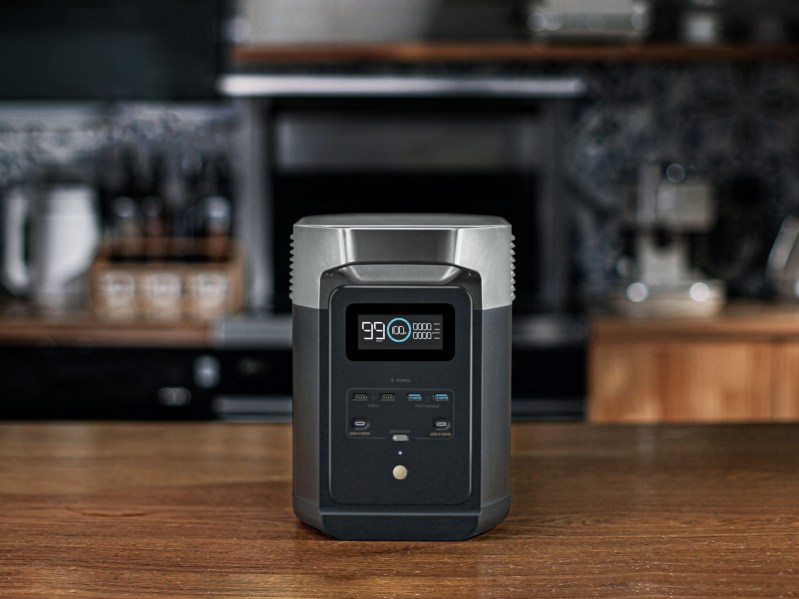
The EcoFlow Delta 2 is both a portable power station and a home backup battery system. In other words, once charged, it can be used just about anywhere to power electronics, appliances, and more. It can be charged in several ways, such as through a regular outlet, solar power with solar panels attached, and more.
If you pair up an EcoFlow Smart Extra Battery you can extend the power capacity even more, up to 2,048 watt-hours, or with the Max Extra Battery up to 3,040 watt-hours. For the uninitiated, that’s enough power to supply the average family and to keep an entire home running for about a week (and potentially longer).
Think of it as a sort of electric generator, except it doesn’t use gas, produces no harmful emissions, and is generally much more user-friendly and easy to set up. Really, the only thing you have to do is plug devices into it — there are a host of outlets and options at your disposal.
EcoFlow claims it will hold its charge for up to six times longer than comparable systems, and after ten years it will still be able to hit 80% of its original capacity. That’s because the LFP battery type is incredibly efficient and reliable and will last for about 3,000 cycles, likely more.
What are the features of the EcoFlow Delta 2?
- It has a capacity of 1,024 watt-hours
- LiFePO4 battery lasts up to 3,000+ cycles
- 6 AC outlets and 7 USB ports
- Charges via AC in just 1.3 hours
- Charges via solar (500 watts) in 3 hours
- Power electronics, small appliances, and more
- Weighs about 27 pounds
- Built-in display for stats
- Syncs with mobile app via Bluetooth
Now that you know the basics, let’s move on.
What do I like about the EcoFlow Delta 2?
- It’s reliable: You can power nearly everything you’d need during an outage, from small electronics to cooking appliances and beyond. I used the Delta 2 to do just that during this storm.
- It’s lightweight: At 27 pounds, and with built-in carrying handles, the Delta 2 is actually fairly easy to move around and certainly fits inside the trunk of even smaller vehicles. Up against traditional generators, there is no comparison; this is so much more convenient.
- You can use it indoors: Hopefully, you know this, but you cannot use a traditional generator indoors and within enclosed spaces. The toxic emissions are deadly. The Delta 2, and electric portable power stations like it, can be used safely inside your home.
- There’s no guesswork: The built-in display tells you at a glance how much of the battery capacity is left, including how much time you can expect to continue powering whatever you have plugged in. You can also use the EcoFlow app to check this information too.
What do I not like about the EcoFlow Delta 2?
- You can’t rely on the app: It can be challenging to sync your phone with the device the first time, and even after that. You’ll need to be close to the unit to make any changes because you have to power on the unit directly.
- It’s expensive: The EcoFlow Delta 2 alone is $1,000, while each Delta 2 Extra Battery is $800. Compared to other power stations, that’s not so bad, but it’s still a major commitment to make for most people.
Why would you want an EcoFlow Delta 2 or a portable power station?
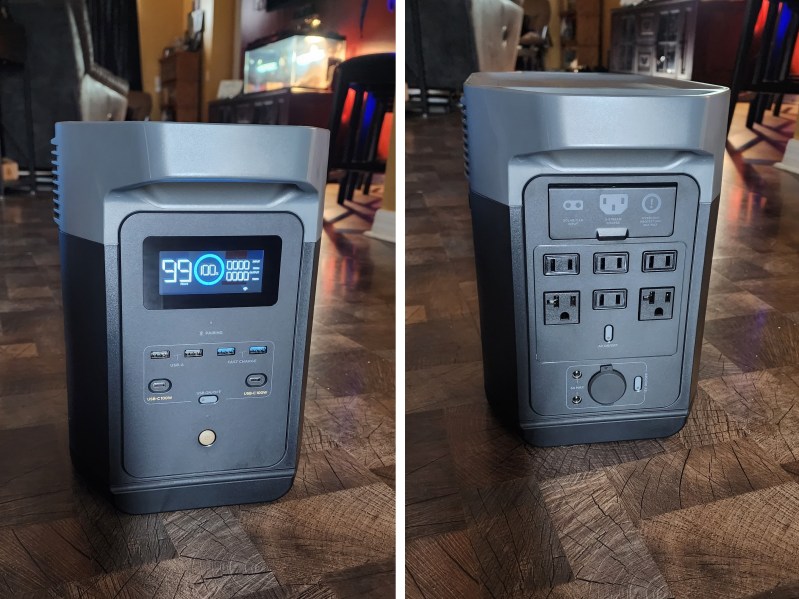
The obvious use case is to continue supplying power to your home during an outage. But that’s not the only reason for owning a portable power station like the Delta 2. Because they’re relatively lightweight, you can bring them anywhere, like on a road trip, camping, or even while you’re living off-grid. The fact that you can hook up solar panels, up to 500 watts, and charge to full in about three hours, opens up a whole world of new possibilities.
Outside of major events, you could use this thing poolside, at the beach, in your backyard, or while visiting friends and family. For instance, if you wanted to host an impromptu movie night outside and hook up a projector and small surround system, you can do that, and you don’t have to worry about having outlets nearby or running an unsightly extension cable.
As for why I wanted a portable power station, I just want to make sure my family has power, and with Ian barreling toward us, that was a very prescient concern for me. To be upfront, I did not lose power entirely, which is a miracle because everyone around us did and they were without power for more than a couple of days. However, my power did flicker constantly, which made doing anything for long nearly impossible. We couldn’t cook dinner, for example, because the power to the oven kept failing. We also powered a small TV so we could keep an eye on news updates and watch the storm’s path in real-time.
Weathering a storm with the EcoFlow Delta 2
According to the experts offering advice on how to survive a hurricane, batteries, or power banks, are absolute essentials. The EcoFlow Delta 2 certainly fits that bill. If you have the opportunity, you should get one. However, during my time dodging Ian, utilizing power stations, and securing my home, I learned a few important lessons, which I will carry over into future experiences, and I hope to share them with others here.
Lesson 1: Go ahead and get an extra battery
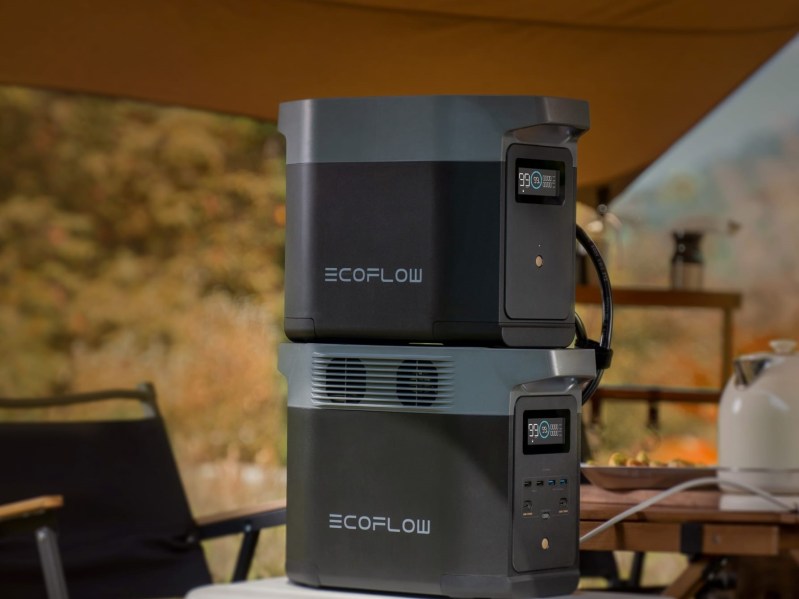
While the Delta 2 is a must-have and does a great job of supplying power and remaining pretty reliable, eventually you’re going to run out of juice. So, my recommendation is to go ahead and just pick up an extra battery or two to extend the system capacity. Throughout the week of the storm, I found myself constantly stressed over power, even with a backup solution, and with those extra batteries it would have brought tremendous peace of mind.
Most of the substantial power station brands on the market offer some extra battery solutions. Regardless of which station you get, get some extra batteries too.
Here are some of the estimated power times for various items, for just the Delta 2 alone with no batteries added:
- Phone at 11 watt-hours: 89 charges
- Laptop at 60 watt-hours: 16 charges
- Light at 10-watts: 31 hours
- WiFi router at 10-watts: 31 hours
- Small fan at 40-watts: 16 hours
- TV at 110-watts: 8 hours
- Refrigerator at 120-watts: 7-14 hours
- Coffee maker at 1,000-watts: 0.8 hours
- Electric grill at 1,150-watts: 0.7 hours
Lesson 2: Know what you’re powering beforehand
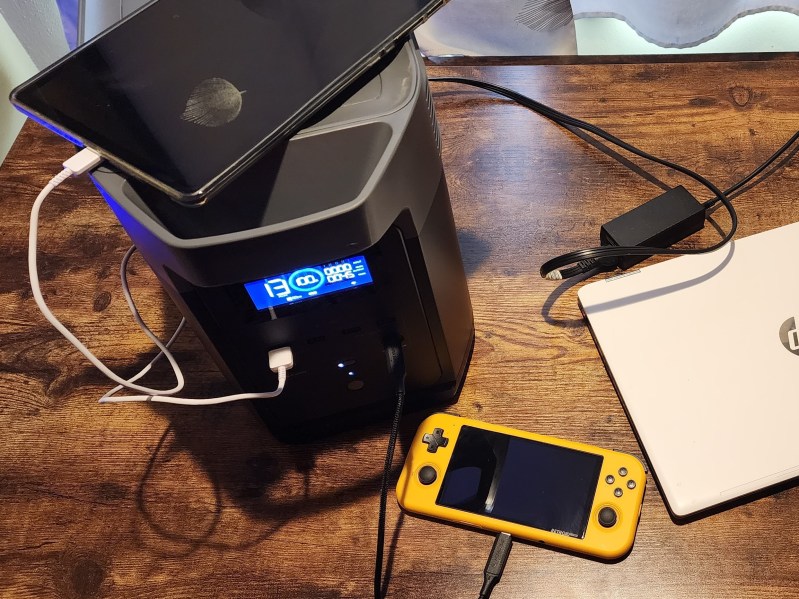
Similar to a bug-out plan or a survival plan, you need to discern a strategy before a storm or outage happens. In other words, figure out what’s essential and what you’ll need power for, and then test out your plan at least once.
You’ll learn how long your power station can sustain your needs, and whether or not you should have any extra gear like batteries, or even another station. For example, I learned it would be beneficial to have the Delta 2 for major gear, including appliances, and then another smaller unit for mobile devices, emergency electronics, and so on. In my case, I had the handy, which I purchased myself in advance of the storm. I used that to keep my phone, my wife’s phone, and my children’s tablets going — the latter to keep them distracted from the scary wind and rain battering the walls of our home. It should also be noted that entertainment is something you should include when setting up a proper at-home emergency kit. Trust me, you’ll have a lot of downtime.
As for EcoFlow’s power station, here are some of the things I powered with the Delta 2 in my home:
- A standing fan
- Portable AC
- Tablets and phones
- Steam Deck and Nintendo Switch
- Retroid Pocket 3
- A small fridge
- Lights
- Oven/air fryer
- TV for news updates
- Modem and router
You’ll need to prioritize based on what you and your family need most, and keep in mind that some of the things listed I didn’t keep powered on the entire time. The air fryer, for example, I used for a few minutes to cook some dinner. Everything I plugged in worked well with the Delta 2, which is a testament to its reliability.
Lesson 3: Have more than one power station at the ready
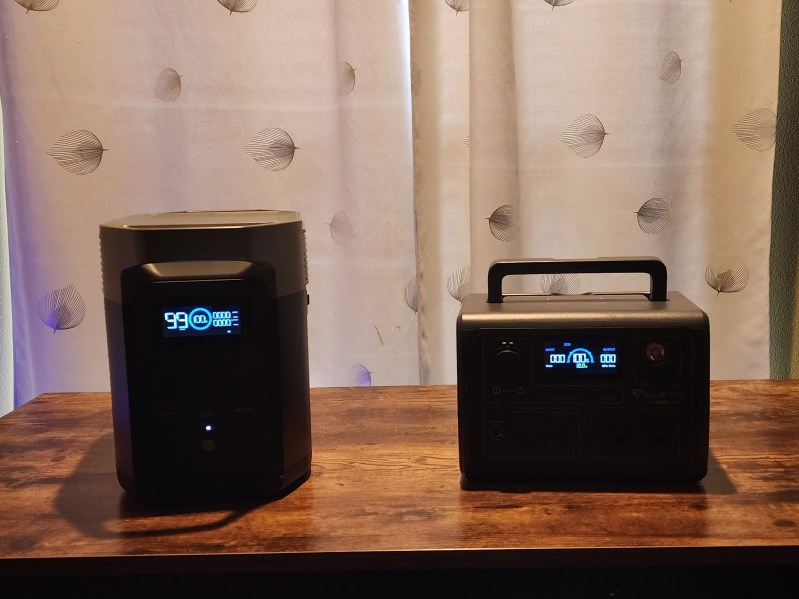
As I just mentioned, it’s always good to have multiple options at the ready. The Delta 2 is amazing, but it’s certainly not going to sustain a whole family’s needs, by itself, at least not for longer than a couple of days. There’s no telling how long you might lose power in a big storm like Ian.
That’s precisely where those extra batteries come in handy, significantly boosting the power systems’ capacity. But having another station around gives you even more options, like placing it in a room where your family is protected, as opposed to just keeping the major appliances on. You don’t want to be hiding out in a kitchen with windows, for instance; you want to be in a central room with no windows and walls on all sides. If you have an extra power station, you can use something like the Delta 2 to keep your fridge and essentials powered on, and then place the secondary station in the designated shelter room. I’m grateful I had the smaller EB3A, but it’s definitely something to plan for in advance.
The ultimate lesson: Act now
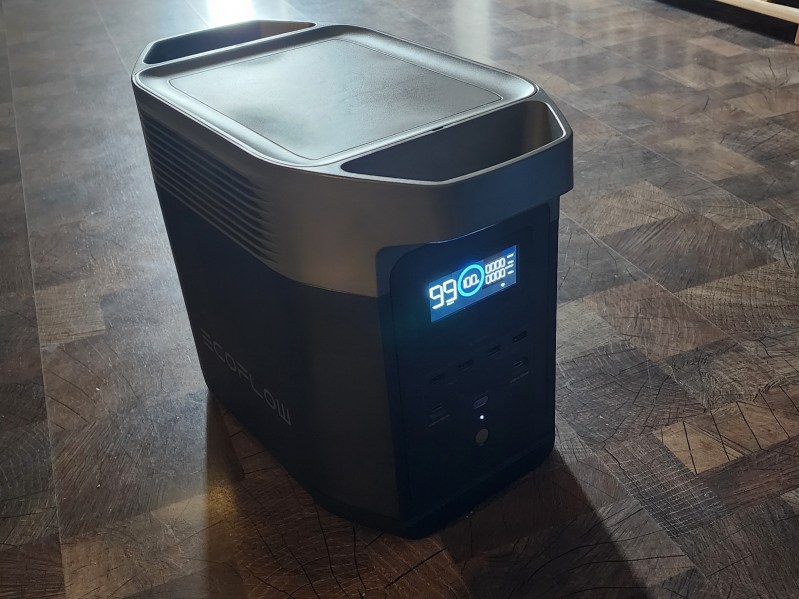
You’d be surprised how easy it is to forget this especially when you’re busy with life, but the best action you can take for yourself and your family is to plan now. Right now, after reading this and while it’s on your mind.
I didn’t, at least when it comes to having a power solution. We had our water, we had our food, and we had our house protected, but what we didn’t have, outside of the smaller Bluetti EB3A, was a power solution like the EcoFlow Delta 2. If the power went out for any extended amount of time we would have lost all of our food, our milk (which is a big deal for my kids), our frozen goods, and so much more. We also would have been without a comfortable home because the AC would have been off and it would have gotten really warm, really fast. You can’t just open a window in the middle of a storm either. The Delta 2 can at least power a fan, a small portable AC unit, or something to keep you cool.
The good news is that now I have some experience with all of this, and I have a plan in place for future hurricanes for what I’m going to keep powered on and how I’m going to do that. I’m grateful I now have the EcoFlow Delta 2 to fall back on should our power ever go out again.
If you’re interested, you can use code DTDELTA2 to save up to $100 on EcoFlow Delta 2 systems and bundles at Wellbots.com.
Disclaimer: Wellbots graciously provided the EcoFlow Delta 2 sample I used in this review and during the storm.




